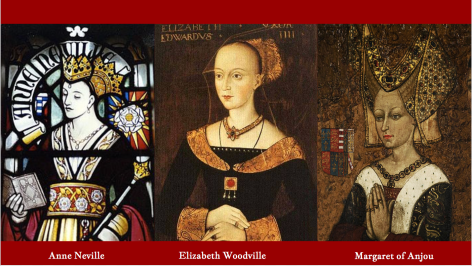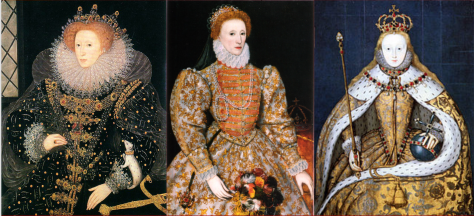
I am a third-year student at SDSU studying English with a certificate in editing and publishing. I worked on the set design and graphics for the class production of Shakespeare’s Richard III. I am an artist, a writer, and a photographer. I have a passion for the arts and as such greatly enjoyed working on this wonderful class project.
Jewelry in the Medieval Era:
Gothic Style: 500-1500 A.D
- Replaced Romanesque style.
- High neck dresses were going out of fashion and lower cut dresses were coming in.
- Loose hair with delicate ornamental headpieces became the style.
- Gemstones and precious metals were readily available because of expanding trade and this caused a surge in the jewelry market.
- The gem cutting and metalsmithing industries grew.
- And because of the availability of gems and metals, laws were actually put in place to keep the lower class from owning certain types of jewelry.
Materials and Popular Aesthetics
- Gems were set against a plain background such as niello or enamel although gold was the most popular setting.
- Around 1290 A.D. basse-taille enamel replaced the ancient champlevé enamel.
- After 70 years basse-taille was in turn replaced by émail en ronde bosse technique which allowed for three-dimensional images to be created. Plique à jour was first seen in 1375 and reemerged in the 15th century.
- Indian and Persian gem-cutting techniques allowed for a drastic change in jewelry style.
- Diamonds had only been cut as octahedrons until that point and colored stones had only been cut as cabochons.
- By the 14th century point and table cut diamonds were introduced.


Richy-Rich and His Bling
- Collar has roses each with four petals that represent the female creation of life i.e. the Virgin Mary in conjunction with the lozenge-shaped borders.
- The pearls with the lozenges enforce the idea of purity
- Fleur-de-lys and lilacs symbolize France, Richard’s Plantagenet heritage.
- Cap brooch is a Greek cross with five pearls and a ruby in the center
- Greek crosses do not represent crucifixion they represent the cardinal points and the spread of Christianity

Richy-Rich and His Bling Cont.
- This painting from the 16th century is based on a now lost portrait of Richard III painted between 1483 and 1485.
- Rose brooch on cap religious and personal meaning
- Petals of jet or black agate center is a ruby
- Jet agate: grief, mourning, and safe travel
- Black agate: courage, boldness, vigor, and prosperity
- Ruby: royalty
- Petals of jet or black agate center is a ruby
- Ring on the third finger of the left hand represents love, faithfulness, and marriage
- He is seen playing with his ring which may symbolize his readiness to remarry after Anne Neville’s death in 1485.


Elizabethan Era: 1558-1603
- Before Elizabeth’s reign, men had been wearing more jewelry than women. With her clear love of jewelry Elizabeth set a new trend of women wearing more elaborate and beautiful pieces than men.
- Low necklines had become popular after the beginning of the medieval era. However, in Elizabeth’s era, the high closed neckline was popularized again. Necklaces with large pendants were very ‘in’.
- Brooches, rings, necklaces, pendants, earrings (ear pickes), and watches were all commonly seen items. And they were usually made of gold and silver and inlaid with gems like diamonds, rubies, opals, and sapphires.
- Pearls were incredibly popular, owning a string of pearls or even a single pearl on a necklace was a fashion must.

Willy Shakes

Questions
- What enamel style would have been popular during Richard III’s lifetime?
-
- Basse-taille
- Email en ronde bosse
- Plique à jour
- Champlevé
- What is the significance of the rose-shaped cap-pin in the 16th-century portrait of Richard III?
-
- It signifies the house of York
- It signifies his grief and personal strength
- It signifies his love for Anne
- Both a & b
-
- Gothic jewelry directly followed and was inspired by which of the following periods?
-
- Byzantine
- Renaissance
- Romanesque
- Germanic
-
- What did Elizabeth bring back?
-
- Ruffled collars
- High closed necklines
- Whiteface makeup
- Backstreet
-
Works Cited
Alchin, Linda. “Elizabethan Jewelry.” Elizabethan Era, 2012. Web. 11 March. 2018.
www.elizabethan-era.org.uk/elizabethan-jewelry.htm
Antique Jewelry University: Dynamic Online Encyclopedia, Antique Jewelry
University, Web. 1o March. 2018. www.langantiques.com/university/Medieval_Jewelry
“Portrait of Richard III.” Teaching History with 100 Objects, The British Museum, Web. 10
March. 2018. www.teachinghistory100.org/objects/about_the_object/portrait_of_richard_iii
Wilkinson, Josephine. “Religious and Personal Symbolism in Richard III’s
Jewellery.” Dr. Josephine Wilkinson, 5 Mar. 2013. Web. 12 March. 2018. www.josepha-josephine-wilkinson.blogspot.com/2013/03/religious-and-personal-symbolism-in.html

